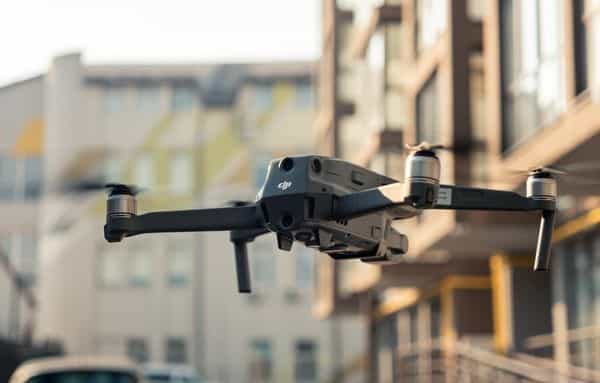The DJI Mavic 2 Enterprise Advanced (M2EA) is an impressive drone developed for industrial use. In this review, we delve into the drone’s main features, its applications, pricing, and who should consider investing in one.
DJI Mavic 2 Enterprise Advanced Design
The DJI Mavic 2 Enterprise Advanced (M2EA) is a compact, foldable drone designed for professionals with robust construction and advanced imaging capabilities. A dual camera system, consisting of a 48MP visual camera and a radiometric camera, is mounted on a 3-axis gimbal to ensure stable footage and accurate temperature measurements. The drone is equipped with a high-capacity LiPo intelligent battery, provides up to 31 minutes of flight time, and offers omni-directional obstacle sensing and AirSense technology for safe operation. The M2EA also supports modular accessories such as spotlights, loudspeakers and beacons for added versatility in different missions. The drone is compatible with DJI Smart Controllers with an ergonomic design and built-in 5.5” ultra-bright display, and supports OcuSync 2.0 for a reliable connection with a range of up to 10km doing. Overall, M2EA is a powerful, portable and versatile tool for professionals in various industries.
Advanced Features of DJI Mavic 2 Enterprise
dual camera system
The M2EA boasts a dual camera setup with a 48MP visual camera with a 1/2″ CMOS sensor and a radiometric thermal camera with 640×512 resolution. The visual camera offers 4x lossless zoom and 32x digital zoom, allowing users to capture stunning aerial photos and videos. The thermal camera, on the other hand, offers accurate temperature measurements and has a 16x zoom. It is useful for various applications such as search and rescue, inspection, and firefighting.
RTK module
M2EA has Precision RTK module, enabling centimeter-level positioning and waypoint planning accuracy. This feature is essential for surveying. mappingand the inspection where accuracy is paramount.
flight time and range
With a maximum flight time of 31 minutes and a maximum range of 10 km, the M2EA allows users to easily cover large areas. The drone’s OcuSync 2.0 transmission technology ensures a stable and reliable connection, delivering a live HD video feed even in challenging environments.
AirSense technology
Safety is a top priority at M2EA. The drone is equipped with AirSense technology that can detect nearby manned aircraft and alert the user to help maintain a safe distance and avoid potential collisions.
Modular accessories
M2EA is compatible with a variety of modular accessories such as spotlights, loudspeakers, beacons and more. They can be easily attached to the drone, enhancing its capabilities and suitable for a variety of applications.
DJI Mavic 2 Enterprise Advanced Application
M2EA’s thermal imaging capabilities enable first responders to locate missing persons and quickly detect thermal signatures in an emergency.A high-definition dual-camera system allows the drone to be used for emergency missions day and night, but also in harsh weather conditions, but drones are not waterproof.
Infrastructure inspection
With the drone’s high-definition camera and RTK module, Inspection of critical infrastructure Save time and reduce the risks associated with manual inspections of power lines, bridges, pipelines and more.
Agriculture
M2EA can be used to monitor crop health, identify pests and evaluate irrigation systems, helping farmers make informed decisions and optimize their operations.Can use drone for security purposesfarmers can also monitor suspicious activity and find missing livestock
wildlife conservation
Researchers and conservationists can use M2EA to monitor wildlife populations, track migration patterns, and detect illegal activities such as poaching.
Disaster response
In the aftermath of natural disasters, M2EA can help assess damage, identify survivors, and assist relief efforts.
price
The DJI Mavic 2 Enterprise Advanced costs around $6,500 and includes the drone, remote controller, one battery and a set of propellers. Adding accessories and packages such as the Fly More Kit and RTK modules can increase the overall cost.
Who should use it?
The M2EA is primarily designed for professionals who need reliable, high-performance drones for a variety of applications, including search and rescue, infrastructure inspection, agriculture, and wildlife conservation. While the price may be steep for casual users, M2EA’s advanced features and versatility make it a worthwhile investment for users who need powerful tools to enhance their operations.
What is the difference between Mavic 2 Advanced and Mavic 2 Advanced Enterprise?
The main differences between the DJI Mavic 2 Enterprise Advanced (M2EA) and DJI Mavic 2 Enterprise Dual (M2ED, also known as Mavic 2 Enterprise Thermal) are in the camera system, thermal resolution, and some additional features.
The M2EA features a dual camera setup with a 48MP visual camera (1/2 inch CMOS sensor) and a radiometer. thermal camera At a resolution of 640×512. The visual camera offers 4x lossless zoom and 32x digital zoom.
The M2ED, on the other hand, has a lower resolution dual camera system with a 12MP visual camera (1/2.3 inch CMOS sensor) and a thermal camera with 160×120 resolution. M2ED does not offer lossless zoom.
M2EA’s infrared camera has a high resolution of 640×512, and M2ED’s infrared camera has a low resolution of 160×120. The high thermal resolution of M2EA enables more accurate temperature measurements and improves image quality in various applications such as search and rescue and inspection.
M2EA supports an optional RTK module to provide centimeter-level positioning and waypoint planning accuracy. This feature is useful for surveying, mapping, and inspection where accuracy is of utmost importance. However, M2ED does not have an RTK module option.
M2EA is more expensive than M2ED due to its better camera system, higher thermal resolution and compatibility with RTK modules. M2EA costs around $6,500, while M2ED costs around $3,500.
final thoughts
In summary, the Mavic 2 Enterprise Advanced offers a more powerful camera system, higher thermal resolution, and the option to add an RTK module, making it more suitable for professional applications that require advanced imaging capabilities and precise positioning. . The Mavic 2 Enterprise Dual is a more affordable option, but its lower resolution camera and temperature sensor make it suitable for less demanding applications.
